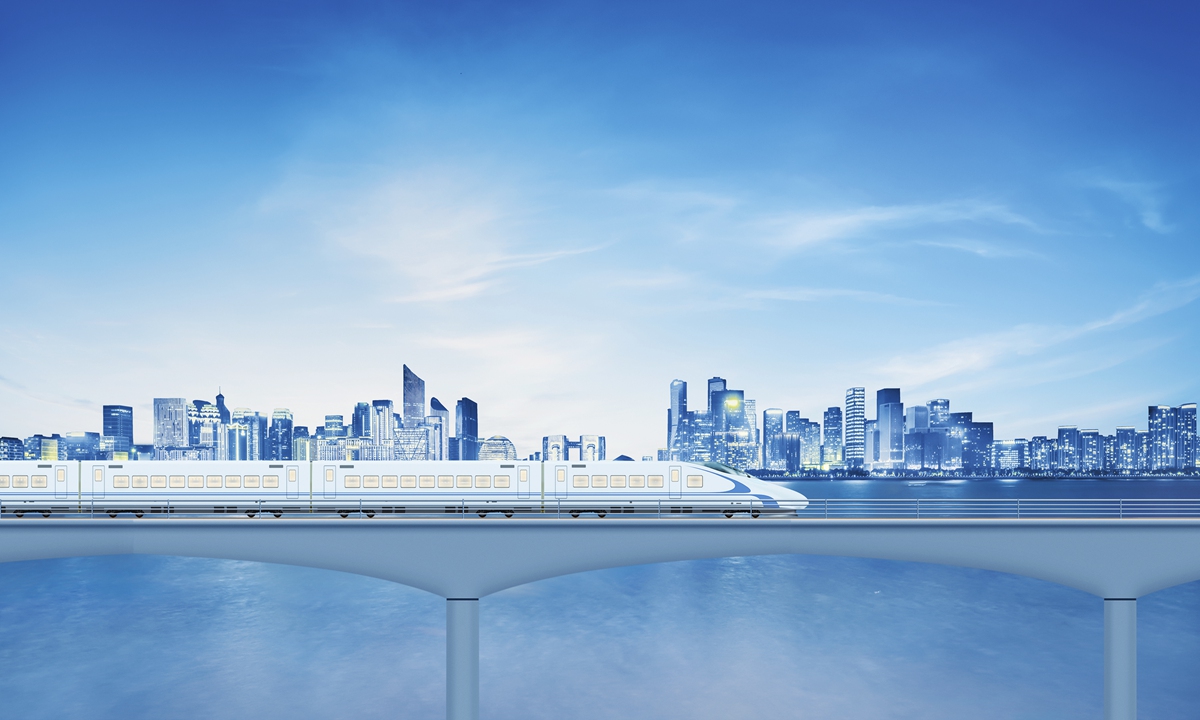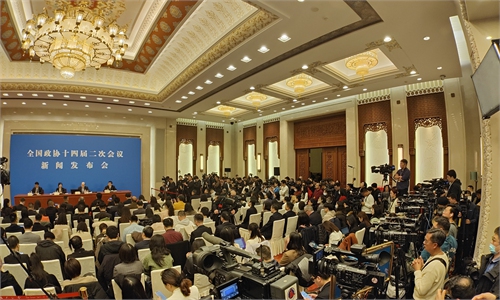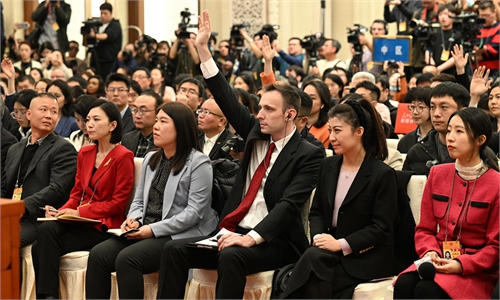TWO SESSIONS 2024 / OPINION
China shows entrepreneurship, speed of modernization while envisioning future avenues

The view of a high-speed rail in Hangzhou, East China's Zhejiang Province. Photo: VCG
Editor's Note:
China's annual two sessions have begun this week. This critical series of meetings in spring is vital to defining China's approach to economic, political and foreign policy issues for the whole year. It also offers observers a window into the latest ideas and practices of China's development in various aspects, including the whole-process people's democracy, high-quality development, Chinese modernization and the wisdom the country provides to global governance.
In the fifth piece of the series "Two sessions inspirations," Augusto Soto (Soto), director of the "Dialogue with China Project," a Spain-based website aiming to promote a better understanding of China, shared his insights on Chinese modernization with Global Times (GT) reporter Xia Wenxin.
GT: What are your expectations for this year's event? What do you think about the significance of China's two sessions and the decisions to be made?
Soto: It is one of the world's most important political events of the year, which means it is an opportunity for the international community to take note of the initiatives for the coming year announced by a leadership that governs almost a fifth of mankind, interdependent with the rest of the world as nearly two-thirds of countries trade more with China than with any other country.
What matters is the announcement of the government's growth target and the overall direction for economic, social and foreign policies for 2024. The national economy seems to be shifting, coinciding with a world in need to make an epochal energy transition and so far China appears to be in a privileged position to provide new low-carbon infrastructure, connectivity and appliances. I would venture to say that an announcement of some steps to developing new quality productive forces among the priorities for this year's economic work is likely.
That would entail fostering advanced productivity through revolutionary technology breakthroughs, innovative allocation of production factors and deepened industrial upgrading. Future industries such as new energy and quantum technology, along with traditional industries becoming smarter and more innovative, are topics that draw my curiosity. AI-empowered management systems can be found in almost every sector, with China set to become the world's main AI center in one or two decades from now. I would expect the announcement of more detailed measures which will lead the country to that goal.
Also, since China is saluting the unfolding of technological innovation at a sustained pace, I would expect announcements against pollution. So far, air quality has registered significant, though unequal, improvements in different cities and provinces in recent years. In view of an uncertain investment panorama worldwide, I am also curious about new measures to attract foreign investment to China.
Additional measures to stimulate more visitors from around the world (in tune with the recent announcements of visa-free entry for 15 days to a handful of countries) would also be well received internationally.
In sum, the world needs pragmatism, predictability, stability and at the same time qualitative growth in times of global uncertainties, and the two sessions are well known for traditionally boosting confidence in the coming future.
GT: You once said you are a first-hand observer of China's ambitious modernization process spanning several decades. What aspects of Chinese modernization have impressed you the most?
Soto: In 1986, when I moved to China and spent some years studying and working in Beijing, China's trade with the outside world was insignificant. Now, China is the biggest trading partner for most countries. Of course, one reason for this, aside from China's size, lies in its modernization process.
In this process, China shows, first of all, entrepreneurship in solving problems, and second, the speed of modernization while envisioning future avenues. From my own experience in China over the past decades, Beijing has been focusing on eliminating poverty - the goal of eliminating extreme poverty was officially accomplished in 2020. It has been very concentrated in rural areas, and there was a lot to do, particularly in food security and healthcare.
Less than a generation later, local platforms like 5G (developed in the last five years) and 6G (in progress), plus the world's most powerful high-speed rail network, can nurture the economy and development at home and abroad. Before all these promising evolutions, I still remember that at the beginning of the 1980s, it was still hard to make a telephone call in rural China. Now, almost everyone owns a smartphone.
Before 2007, China had no high-speed railways. Now, it not only boosts the world's largest high-speed railway system, as it is widely known, but also Chinese-propelled high-speed railways of various speeds are covering Southeast Asia, including Vietnam, Cambodia and Thailand, and soon Malaysia.
GT: How do you understand the Chinese characteristics of Chinese modernization?
Soto: It is safe to assume that modernization processes share commonalities. Here I highlight salient characteristics of China's modernization process: initially cautious, step by step, "crossing the river by touching the stones," taking into account short, middle and long-term processes and factors.
Beijing not only considers its own path, but also has taken as reference the modernizations of other countries - rich or not, Western or not - but it keeps maneuvering to make its own synthesis along the road. China is a matrix civilization, with an extraordinary size, moving according to its own cycles. I often remind my students that such a civilization is able to absorb influences, digest them and come up with a new synthesis of its own. Just as significant, it is a country that comes up with its own contributions in several fields.
Along the process, Beijing has been respectful of the international order in which its modernization process has thrived and is not involved in any war. From the periphery of the world's productive system, in a few decades, China has positioned itself at the center, as the world's second-biggest economy in nominal terms, and the first in terms of purchasing power parity. Thus, it has not been a disruptive process in the sense that - although meteoric - China has concentrated on development, trade and investment, becoming the top trading partner of over 120 countries and regions and responsible for one-third of the economic growth over the last decade.
It is true that overcapacity and important trade surpluses with important partners have caused concern in the EU. Despite that, negotiations are always the way to address disagreements. All in all, China's modernization has been extremely good for its own people and very positive for the world.
GT: Chinese President Xi Jinping said at the beginning of this year that in the face of the changing and volatile international situation, China and Europe need to build more "bridges." What is your take on the current development of China-Europe relations?
Soto: There is room for significant improvements in Europe-China ties, and building "bridges" could play a beneficial role.
We have successfully completed a post-COVID year tourism cycle. EU-China ties have worked for years under the assumption that people interested in deeper mutual knowledge start by visiting each other's countries. It is an inspirational irreplaceable first-hand real-life experience. Also, people-to-people exchanges and academic and student exchanges are key columns operating as consistent "bridges." In the middle and the long run, human contacts are beneficial, and right now they are moving step by step, in a long-term process to reach the levels of 2019.
"Bridges" are also attitudes and responsibilities. By definition, Europe is the West's civilizational cradle and China is the East's. Due to their respective rich pasts and contemporary accomplishments, the EU and China have responsibilities of their own. For example, on core subjects, a win-win mentality should prevail. In increasing multipolar times, facing a future with more out-of-control climate change events and aware of more black swans, the planet should avoid disaster. Thus, "building bridges" appears both pertinent and urgent.
One could define the EU as an ongoing negotiation process among its member states using procedures, patience and imagination to accommodate the realistic goals of its 27 members. For its part, China knows how to reach its internal consensus to project its own consistent foreign policy. As a result of their respective processes, over long decades, the EU and China have become the world's two most experienced negotiating powers in peaceful times. The EU and China know that despite the lack of consensus in some bilateral fields, agreements can be hammered out and disagreements can be solved at the negotiating table on cyclical convening bases. This is the most significant contribution they can make to a troubled international scenario, having in mind the whole picture, not only their bilateral relations.
GT: Last year was the 10th anniversary of the China-proposed Belt and Road Initiative (BRI). How do you evaluate the achievements of this initiative over the past 10 years? Do you think Europe should be more involved in the BRI? What is the potential of the BRI in Europe, especially in Spain?
Soto: Leading connectivity specialist Parag Khanna, in a fresh January 20 Foreign Policy article titled "The Red Sea Crisis Proves China Was Ahead of the Curve," argues that what we need right now is "to build more pathways for supply to meet demand. The solution to supply shocks is more supply chains." For the global public interest, he contends: "More belts, more roads." So, in this sense, the BRI stays as a reference or inspiration for both the 17 EU countries that have signed a memorandum of understanding (MoU) and those that have not. The EU's Global Gateway project is a manifestation of that.
I think that not signing BRI's MoU does not mean that the bloc as a whole might rule out cooperating with BRI in other continents in a hypothetical future with geoeconomic, geopolitical and climate change events in flux. To see BRI and Global Gateway strategy cooperating in developing and post-conflict countries would be synergetic. In a word, to explore infrastructure and connectivity cooperation, if not in most fields and places, in the ones we can, is a realistic move.
Against the backdrop of an international economic landscape increasingly multipolar, and with significant supply chain bottlenecks and disruptions experienced by the Suez Canal, or drought threatening the Panama Canal, connectivity is back as a hot issue. It should be taken very seriously.
For our country, the BRI has brought the Yiwu-Madrid freight rail service, BRI's terrestrial flagship project. I coincide with Carlos Santana, our major expert on supply chains and terrestrial communication in Spain and Europe that the "BRI is the umbrella almost covering everything related to China in terms of the economy, politics, development, infrastructure and trade."


